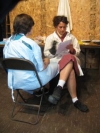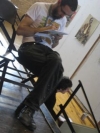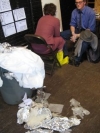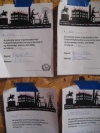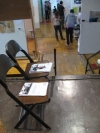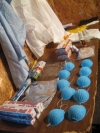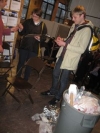Cultural Prophylactics
A Research-Based Performance piece, 2009
Version Fest, Chicago, Il
The core of the project was a series of interviews with artists on the value of creative work. The interviewers, Anne Elizabeth Moore and I, donned business attire, lab coats, or Tyvek suits and supplemented our outfits with protective health and safety devices. Playing with elements of the performance, like our seating arrangements and the use (or overuse) of the protective devices, became points of connection or barriers to intimacy. They became aspects that affected participants’ answers to the survey questions and their comfort levels with the process. Did we create the illusion of intimacy while sitting closely with a participant, inviting more candid answers as the survey questions became more personal? Were the safety devices creating an unsafe environment in which to share opinions about culture, access, and health? The element of anxiety created by the objects and actions reinforced the emotional environment upon which the piece was built.
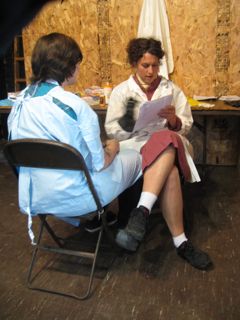
Information was gleaned from verbal and written responses and from respondents’ engagement in the creative process. They were asked, directly and indirectly, to draw parallels between the notion of public health and its connections to creative freedom. The results reflected a range of awareness among our participants about the connections between cultural production and rights issues such as labor compensation, gender discrepancies, and racial diversity. Our survey findings are presented humorously, our interviews conducted performatively, and information gleaned creatively.
Respondents were asked to agree or disagree with a series of questions, and the ratio of favored responses to disfavored responses is listed following their answer, except in cases where the answers were unanimous (with a 100% correspondence rate) or inconclusive (containing a 1:1 ratio).
- Do you consider yourself a commercial artist? No (2:1).
- Can everyone make art? Yes (10:1).
- Is culture inevitable? Yes (10:1).
- Does the future look good? Yes (2:1).
- Do you think your voice counts? Yes (5:1).
- Do you watch television? Yes (4:1).
- Would you donate money to a political campaign? Yes (2:1).
- Would you donate money a youth dance troupe? Yes (3:1).
- Would you buy a candy bar from a kid on the street selling them for his basketball team? Yes (3:1).
- Would you donate money to support your friend’s art project? Yes (22:1).
- Is all money dirty? Inconclusive.
- Is benefiting from the labor of others dirty? Yes (2.5:1).
- Is benefiting from the labor of others without their consent dirty? Yes (5:1).
- Does everyone really “gotta eat”? Yes (9:1).
For a more complete collection of findings from our survey that pertain to arts funding, federal spending, personal income, and related matters of capital click here.








